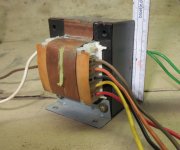I got this transformer with no power rating. There are output voltages with center tap 35-30-0-30-35 VAC. If I load a 0-30V winding with a 4Ohm resistor (no other with the required power available), the voltage drops to 24V
It should be possible to roughly estimate the VA value from this and from the core size.
What do you think? about 100VA?
It should be possible to roughly estimate the VA value from this and from the core size.
What do you think? about 100VA?
Attachments
I normally use a 10% drop in output voltage to ascertain the maximum VA but this is far from certain.
You also need to monitor to rise in core temperature.
You also need to monitor to rise in core temperature.
WHICH voltage drops to 24V?I got this transformer with no power rating. There are output voltages with center tap 35-30-0-30-35 VAC. If I load a 0-30V winding with a 4Ohm resistor (no other with the required power available), the voltage drops to 24V
It should be possible to roughly estimate the VA value from this and from the core size.
What do you think? about 100VA?
That secondary can supply 5-30-35-65-70 VAC 🙄
Please supply the 3 iron core dimensions (short side, long side, stacking).
The question surfaces again and again in many forum sections: if you have enough patience, you can do a search with the right terms, you will find at least half a dozen threads about the subject.
Basically, the methods are based on weight, resistance, size comparison or core area.
It is not an exact science, just approximations.
Here is a sample: Age-old question: reverse, perverse engineering of surplus power xfmrs.
Basically, the methods are based on weight, resistance, size comparison or core area.
It is not an exact science, just approximations.
Here is a sample: Age-old question: reverse, perverse engineering of surplus power xfmrs.
Hi...
Thanks a lot. It is certain enough for me.
I did another test using a cooktop heating element as a load that could run for hours in this way. This has a resistance of 23 ohms. I connected it to the outer connections of the secondary winding, which have 70 Volts at idle. With the 23 ohm resistor, the voltage drops to 62.5 Volts, which roughly corresponds to the above mentioned 10%.
I let it run for one hour. During this time, the temperature of the transformer rose from 21°C to 51°C. If this warming was tolerated, the VA value of the transformer could be assumed to be around 170, with some safety margin maybe around 150VA.
@FauxFrench: You were quite right with your estimation.
I normally use a 10% drop in output voltage to ascertain the maximum VA but this is far from certain.
You also need to monitor to rise in core temperature.
Thanks a lot. It is certain enough for me.
I did another test using a cooktop heating element as a load that could run for hours in this way. This has a resistance of 23 ohms. I connected it to the outer connections of the secondary winding, which have 70 Volts at idle. With the 23 ohm resistor, the voltage drops to 62.5 Volts, which roughly corresponds to the above mentioned 10%.
I let it run for one hour. During this time, the temperature of the transformer rose from 21°C to 51°C. If this warming was tolerated, the VA value of the transformer could be assumed to be around 170, with some safety margin maybe around 150VA.
@FauxFrench: You were quite right with your estimation.
